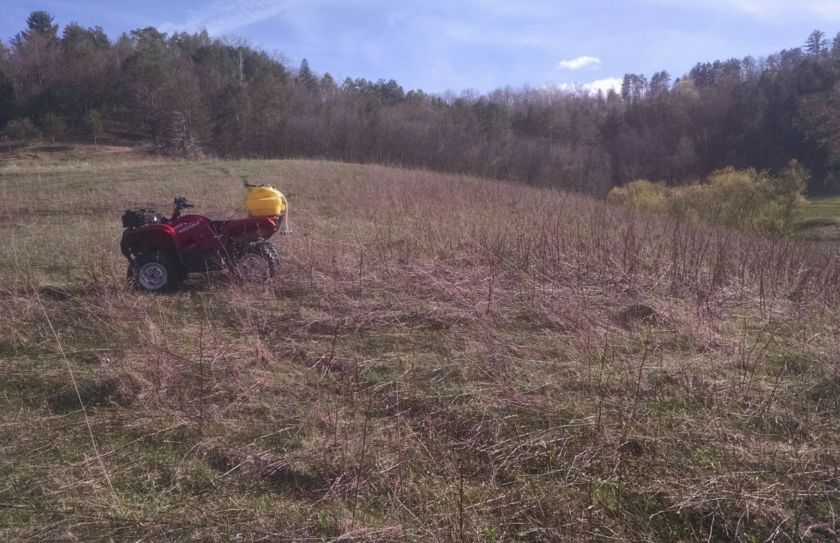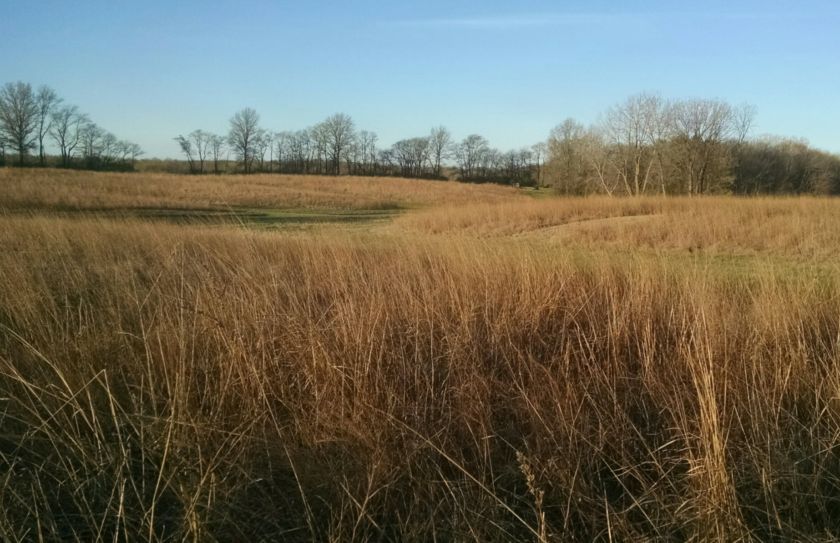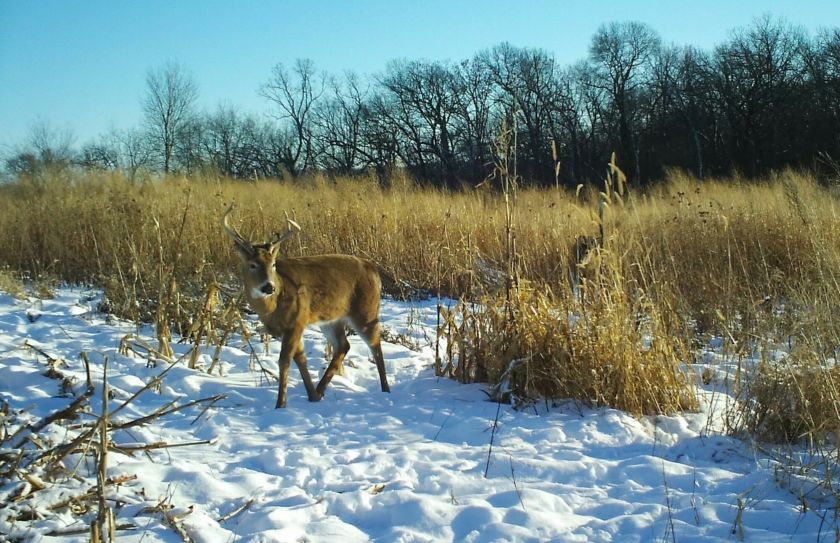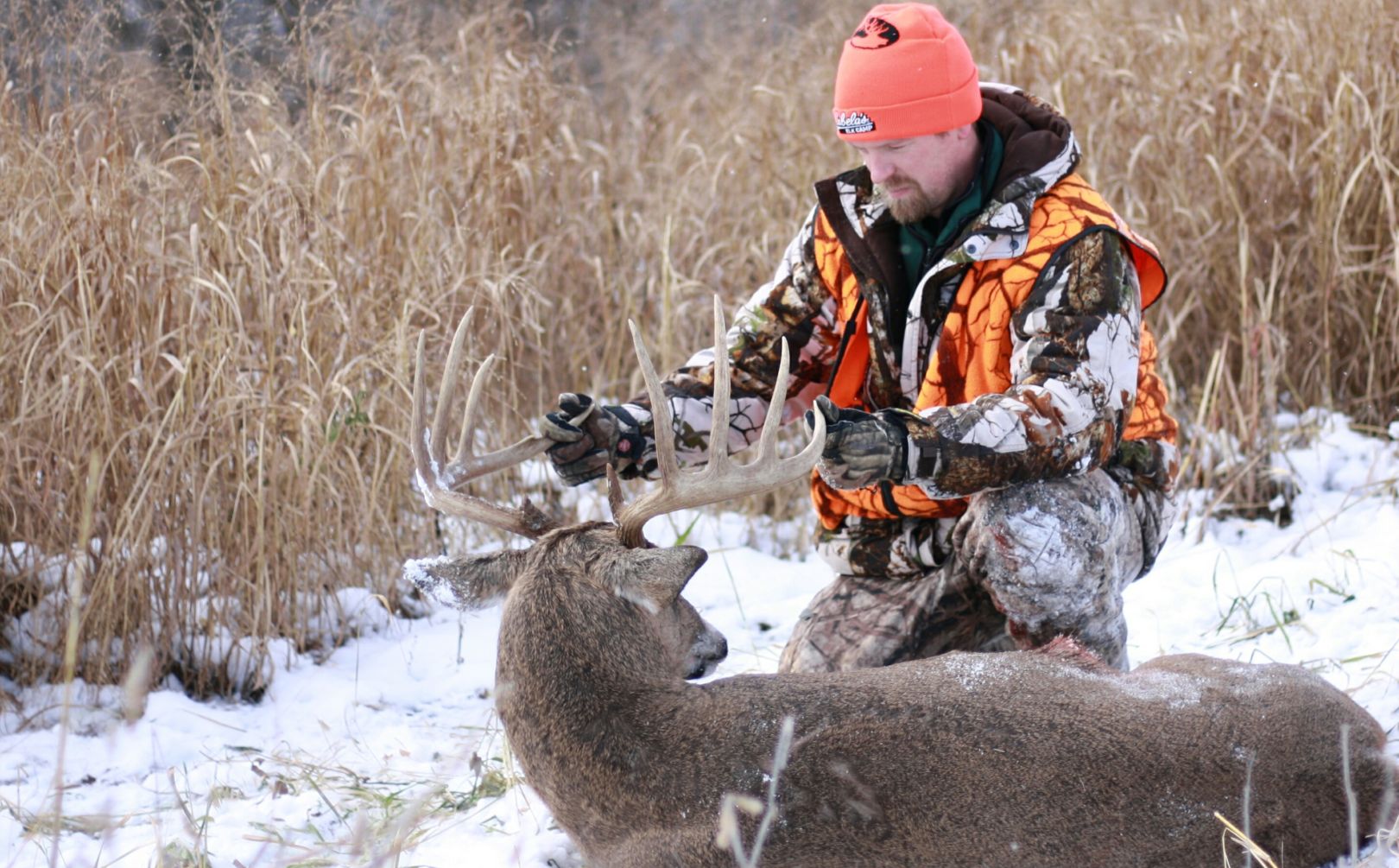
Switchgrass Deer Bedding Considerations
Have you ever wanted to easily create switchgrass plantings for deer, but lack the resources of expensive equipment? Than I encourage you to follow along, because I am excited to discuss these easy, strategic methods for getting the job done.
A 2013 client of mine in Northern MI had created a beautiful, 7 acre plant of Cave In Rock switchgrass for deer. The 3 year old planting was tall, strong and at first appeared to be the perfect deer bedding creation; but it was not. The switchgrass planting was recommended to my client by someone who has had great luck in a large agricultural settings located in Southern MI, where switchgrass can sometimes be an adequate bedding option. But in the area of Northern MI where I was visiting with my client, switchgrass had proven to be a very poor choice due to several reasons:
1. In Northern settings there is what I call a "predator factor"
What that means is that as the acres of cover and numbers of predators increase, deer prefer to bed withing areas of higher visibility, which directly relates to how far that they can see in any one direction while bedding. Deer need to be able to see much further in high cover % and high predator density areas. Any deer within a northern switchgrass planting is basically, "easy prey" to downwind scent checking predators that can slip in quietly, undetected...and unseen due to the stem density of the grass.
2. Lack of food
Deer had many options for bedding areas surrounding the field, that offered them the potential to feed twice during the daytime hours within their bedding areas. Hardwood regeneration areas following major timber harvests, lowland diversity mixes of red osier dogwood, red maple, conifers and aspen provided the perfect blend of "food with a view".
*Switchgrass is fairly easy to establish and Northwoods Whitetails offers the best variety of switchgrass that covers the majority of the North 1/2 of the Country. Make sure to check them out!
3. Available bedding choices
In a flat, Northern Ohio ag region you may be able to stuff 40 deer into a 10 acre field of switchgrass plantings because they have no other bedding choice. However, as you move closer to full-cover regions, that is not the case. Deer have options, and often at a level many times greater than native grasses alone. And that includes switchgrass plantings. The habitat that surrounded my client's land featured 100s of more of potential bedding areas, than actual deer.
The previous habitat on the 7 acres was a mix of lowland shrubs, conifers and pockets of hardwood regen. Although the % of conifers were a little light, the area was still a fairly decent form of Northern MI daytime habitat mix, while being the preferred bedding acres for a handful of deer. Once the switchgrass planting was installed, the deer relocated to the neighbors land across the street and the deer stopped bedding within the 7 acres. The switchgrass actually had the opposite outcome from what the landowner had originally intended, but those results were easy to reverse with a little additional work.
Even though that Northern MI bedding creation wasn't appropriately matched to the conditions, there were still very good reasons to use switchgrass plantings on the property. Those same conditions that repelled deer within the setting, were actually the same conditions that could make a switchgrass planting great for other uses on the land. From what I have experienced through switchgrass plantings from Iowa to Minnesota to Delaware and most points between, switchgrass may be one of the most versatile and misunderstood plantings for deer. Bedding cover, hunter access, downwind blocking features and the overall reduction of herd stress are all reasons to consider a switchgrass planting on your land. And when it is finally time to plant, here is a recipe that can provide you with outstanding results, with a minimum amount of expense or equipment.
Recipe for Switchgrass Plantings
This recipe for Cave In Rock switchgrass was given to me by a client several years ago, and it has been an outstanding plan for establishing any type of switchgrass planting. Cave In Rock is from what I have experienced, the most widely used and planted switchgrass variety. It is easy to find and purchase online, an it is quite possible that your local feed mill will carry it. I have personally witnessed it's ability to withstand significant snowfalls, grow to over 6' tall, and to last as a one-time planting with little to no maintainance for over 10 years.
The Process:
1. Cave In Rock can be purchased from a variety of online sources, commonly priced between $7 and $12 per pound, depending on volume and shiping charges.
2. Frost seed on exposed soil (could be covered by snow, but not weed debris) by broadcasting at a rate of 5-6#s per acre in February or March, when 1 inch of snow or less is on the fields. Make sure that you plant within an area that will receive at least 7-8 hours of daily sunlight during the growing season. The timing for frost seeding would typically take place at least 4 weeks prior to the typical Spring green-up in your area. A light coating of snow is outstanding at the time of your broadcasting, because you can easily see your broadcasting coverage rate. A well prepared seed bed should provide adequate seed to soil contact. An area that has been treated 2-3 times the previous growing season with glyphosate, or lands that were planted in corn or beans the previous year, both make great seed beds and will insure adequate seed to soil contact, which is vital to your success.
3. In April spray Atrizine at a rate of 3-4 quarts per acre during the first 2 years. If you do not have a chemical applicators license, than Simazine can be purchased online.
4. If you choose not to use chemicals, you can mow the field 3 times the first year when the weeds and grasses reach a height of 8-12" high, and then once the following Spring. After the Spring mowing a year after frost seeding, you can let your switchgrass planting take over.
5. The use of chemicals will greatly improve the quality of the stand through reduced weed competition. The growth rate at the end of the 2nd Summer with chemicals, is typically equal to the growth rate at the end of the 3rd Summer, without chemicals.
6. Plan on $50 to $80 per acre, depending on the amount and price of the seed that you purchased, as well as the cost of the chemicals used.
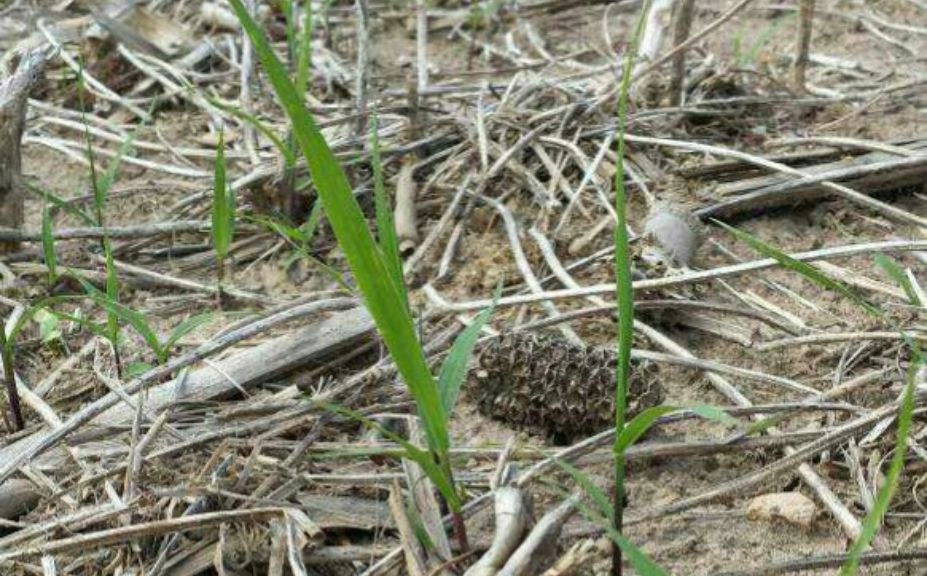
*The February 2013 frost seeding picture above is from July 22nd, 2013, and the picture below is of the same planting as of August 22nd, 2013. 42" in one year!
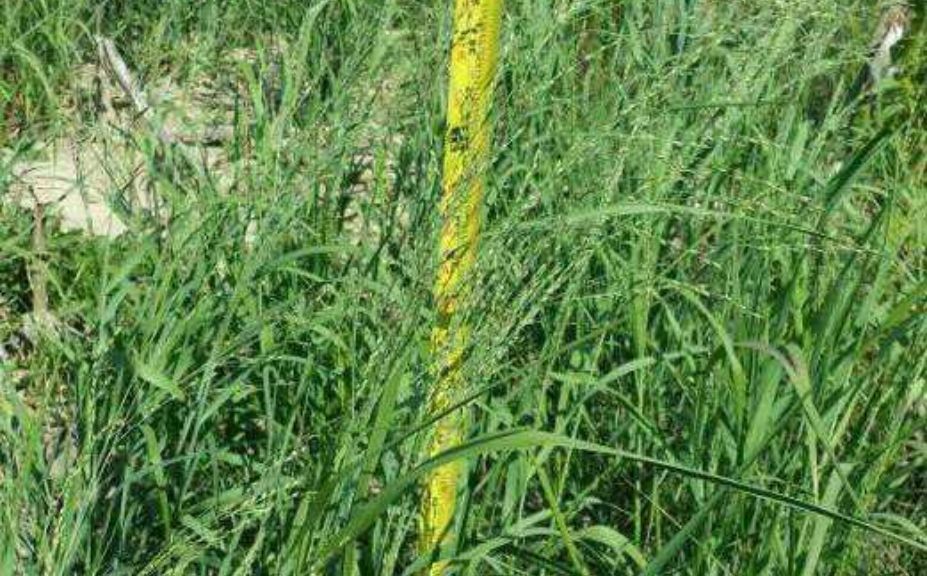
Switchgrass Plantings For Bedding Cover
From what I have experienced across the country, switchgrass is the most commonly misused habitat planting for deer. I would rank the bedding canopy/buck bed/buck bed vs. doe bed as the most commonly misused timber cutting for deer, but that is a completely different topic discussed in The "Top 10 Whitetail Habitat Management Myths", as well as "The Mystery of Building Buck Beds".
Despite the misuse of switchgrass plantings, the seed variety is also one of the most widely appropriate plantings for deer that landowners can make. A large portion of switchgrass plantings can be used for various screening practices which will be discussed next, but here are a few tips to make sure that you are getting the most out of your goals for producing quality bedding opportunities:
1. Deer feed 5 times in a 24 hour period, including twice during the daytime bedding hours. Switchgrass, as well as most native grass blends, contains zero food. There are several bedding mixes that include a mix of various clovers and alfalfa in an attempt to offer a food value within the bedding area. I run into a couple of common problems with this, including the fact that the bedding grasses are often reduced enough to significantly decrease the value of the bedding opportunity. The next problem is that if the food value is too high within the bedding area (clover, alfalfa), there is little need for deer to actually leave the bedding area until after dark, which would be similar to offering a stand of white oaks within a bedding area, or even an apple orchard. By keeping your highest quality food sources on the outside and away from the bedding area, you will place yourself into position to enjoy highly defined afternoon deer movements, from preferred daytime bedding areas, to evening food sources.
*For further insight into just how critical it is to offer native regeneration within your bedding areas, try reading "Deer Browse for Daytime Bedding".
2. In order to use switchgrass plantings in a bedding area, I highly recommend that you disc and disturb the soil to create a maze and pocket effect within the stand, to encourage the early successional growth of briars, various weeds and woody stems (shrubs and trees). Try to establish a goal of turning at least 30-40% of the bedding area into non-switchgrass growth. This will also reduce the predator factor effect, by increasing the openess of the planting, as well as established escape routes within the "maze". You should create the native regen areas within the switchgrass planting, so that the deer that relate to the daytime browse and cover, can be completely hidden within. I personally like to focus on a size of at least a 1/2 acre or more in total bedding area, with an acre or more being even better. If you lack the conditions for significant native regen, planting various shrubs, conifer and tree species to compliment any native growth can be a welcome addition. Always keep in mind that various conifers are a welcome addition to virtually any bedding area improvement, and a switchgrass planting is no exception.
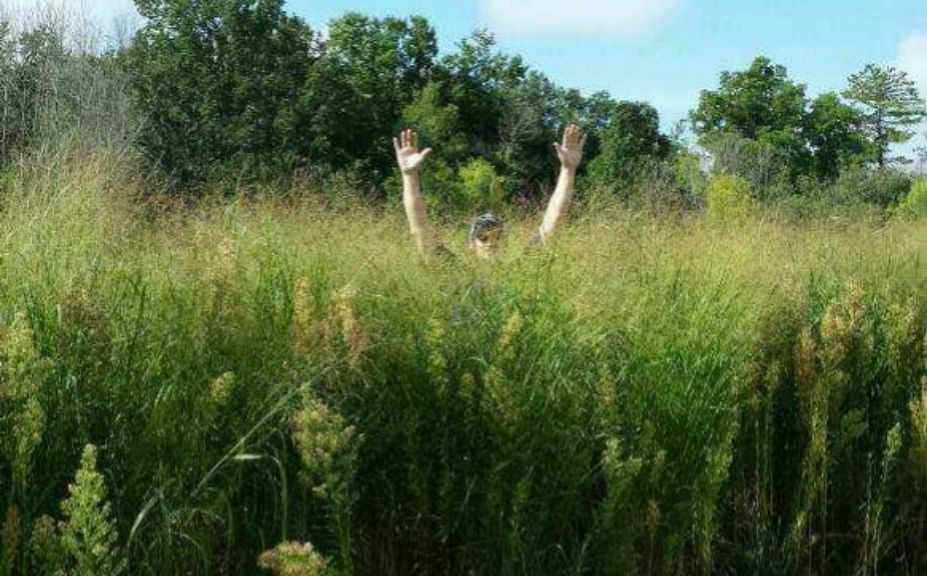
*My client with 40 acres in lower MI, has used his switchgrass plantings to offer an incredible bedding compliment to his large, destination food sources, as well as for screening along the county road. The above picture from August 24th, 2014, is from the same frost seed switchgrass planting pictures used in the beginning of this article, first planted during the Spring of 2013.
Switchgrass Plantings for Screening Cover
For immediate screening cover I love to plant Egyptian Wheat as seen in the picture below. As an annual, Egyptian Wheat can be an outstanding short term solution, while a planting of switchgrass can be considered a great long term option. My favorite tactic is to plant Egyptian Wheat along side the switchgrass planting, so that in 2-3 years when the switchgrass reaches an appreciable height you will eliminate the need to plant, for up to decade or more. Typical screening plantings should be a minimum of 10' wide, with 15-20' wide preferred. Another strategy is to plant 10' wide with switchgrass, and 10' wide with Egyptian Wheat, eventually converting the Egyptian Wheat to switchgrass, to create a 20' wide pure switchgrass screening within 2-3 years.
What should you sceen? Woodlot edges, bedding areas, hunter access routes, ponds, orchards and food plots are all very good habitat features to plant switchgrass along side. Your entire screening goal should be to keep the deer from seeing you, and the deer from seeing each other. Screening various interior islands or lines within a food plot is another great way to reduce the stress among the local deer population. Your goal should always be to hide deer within ther preferred hotspots of food and cover, and a switchgrass planting is a great way to accomplish a very high quality screen.
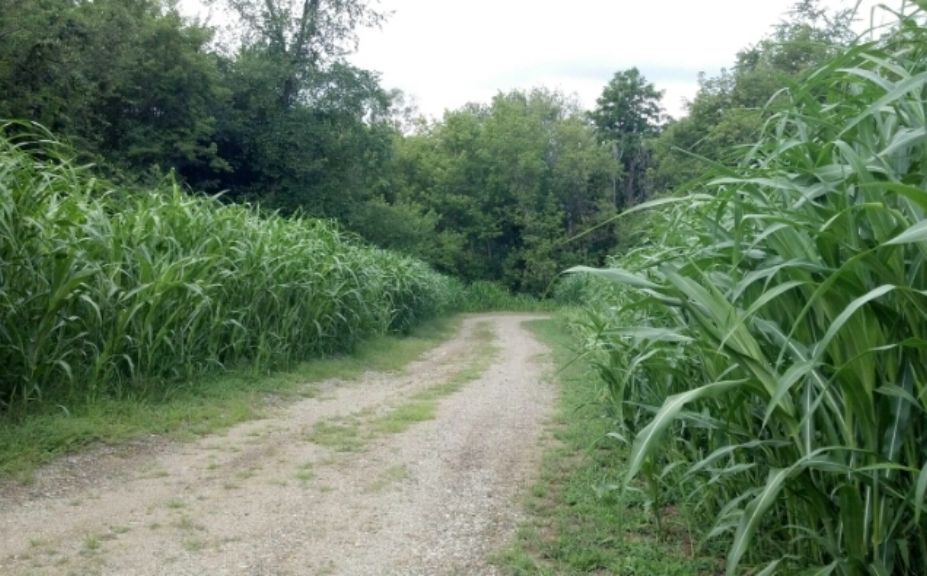
*For more info concerning creating a high quality Egyptian Wheat planting, try reading Egyptian Wheat Screening Strategies.
Switchgrass Plantings for Downwind Blockers
By planting switchgrass at a rate of 10#s, you can create a nearly impassable structure of tangled grasses, by both you and the local deer herd! This offers an outstanding opportunity for you to plant a thick stand of grass to be used on the downwind and approach side, of your stand locations. In many locations deer will not typically bed within switchgrass alone, but in plantings that are at a rate of 10#s, it is nearly impossible to do so. Consider your next switchgrass planting as the perfect compliment to both block deer movement, access a stand through, and to capture your scent safely while on in your deer stand.
Conclusion
The northern MI client's switchgrass offered a fairly quick solution: Take the tractor with a disc attached, and create the desired maze and pocket effect within the planting. Due to the high predator factor in the area, including wolves (UP of MI), I encouraged the landowner to open up to 50% of the interior of the bedding area for native regeration opportunities. Also, due to the slow growth in the area, I recommended that he had pockets of white spruce (light sandy soil) and red osier dogwood to the open, disced pockets to speed-up the process. However, even with a lack of immediate growth, I excpected the deer to immediately begin relating to the switchgrass planting following the discing. which would improve the bedding value of the 7 acres.
Switchgrass is most likely one of the misused, useful habitat planting for deer across the country. If you keep in mind that deer need to feed twice during the daylight hours, you will be well on your way to matching the local conditions to your planting. I also encourage your to try the easy, low-resource, but highly effective method of frost seeding your next switchgrass planting; it may end up being a much easier process than you think!
